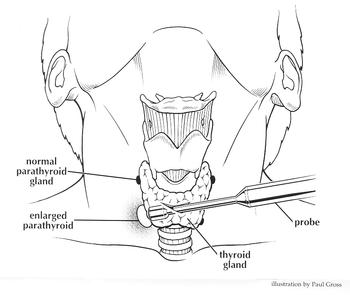New technique pinpoints elusive parathyroid glands

Each of the human body's tiny parathyroid glands is only the size of a grain of rice, but if one goes bad, it can mean big concerns for the patient and a big challenge for the surgeon to remove.
Symptoms, which may include weakened bones and fractures, kidney stones, depression and fatigue, can be devastating for patients. Standard treatment is surgical removal of the enlarged gland, but finding the culprit is the surgeon's biggest challenge because of the parathyroids' tiny size and their propensity to hide in the neck or chest ‹ away from their normal position alongside the thyroid.
Now, Vanderbilt University Medical Center is the first in the region to offer a new, outpatient technique that can drastically reduce surgery time ‹ from several hours to about 30 minutes ‹ and help ensure that the offending gland will be found and removed.
"For a lot of people, this new technique has been a tremendous advantage," said Dr. Richard E. Goldstein, associate professor of Surgery in the division of Surgical Oncology and a member of the Vanderbilt Cancer Center. "Usually, the new procedure is performed with intravenous sedation or local anesthesia. After the procedure, patients are fully awake and alert two hours later, go home and have a regular dinner and can be back at work the next day."
Since last fall, Goldstein has performed about 20 of the new procedures, called minimally invasive radio-guided parathyroidectomy (MIRP). The technique uses a special scan to find the gland, followed by use of a special probe to locate the gland for removal. Goldstein has visited Tampa, Fla., twice to study the procedure with its pioneer, Dr. James Norman.
It was only a century ago that the parathyroids were discovered. The tiny glands have a single responsibility: to regulate blood levels of calcium within a very tight range. When calcium levels dip too low, the parathyroids release a hormone that triggers other mechanisms in the body to bring more calcium into the bloodstream. More calcium may be absorbed from food in the digestive tract, reabsorbed by the kidneys, or calcium may be leached from the bones.
As we all age, the likelihood increases that one of these glands will malfunction. Like a broken thermostat, the gland perceives a normal calcium level as too low and releases its hormone, which then pushes the calcium level above the normal range.
Usually, only one gland malfunctions, and when it does, it becomes englarged. This accounts for 90 percnet of the cases. Rarely, an enlarged parathyroid is associated with malignancy, and this type of cancer can be difficult to cure.
Standard surgery involves general anesthesia, a three-inch incision in the neck, often several hours of surgery to find the enlarged gland, and one to two days of hospitalization. Even then, in some cases, the surgeon is unable to find the enlarged gland.
"It can be very frustrating to the surgeon and especially to the patient," Goldstein said.
The parathyroid scan uses a radioactive isotope called sestamibi that is taken up by the thyroid and parathyroid glands, and is cleared first by the thyroid. Normal parathyroids are too small to be picked up by the scan, so after the substance clears the thyroid, what's left on imaging is the enlarged parathyroid.
"The scan helps cut operating time by pinpointing on which side of the neck the enlarged gland is located, allowing the surgeon to perform a very directed approach," Goldstein said.
At VUMC, Goldstein combines the scan with the use of a hand-held gamma probe, which picks up the radiation emitted by the isotope. The probe is also used by other faculty in Surgery Oncology for sentinel lymph node mapping for melanoma and breast cancer to trace the path of the spread of the cancer.
After undergoing the parathyroid scan in Radiology, the patient goes to the Day Surgery Center in The Vanderbilt Clinic for the procedure, which is done with intravenous sedation and a local anesthetic.
"The incision we use is only about an inch-and-half long," Goldstein said. "The gamma probe guides us right to where the enlarged gland is located, and we remove it. This may take us only about a half hour, compared to often several hours using the traditional method."
Currently, Goldstein operates on about 60 patients each year with an enlarged parathyroid, and MIRP is appropriate for than half with this condition, he estimates.
In addition to using the procedure in adults, Goldstein has collaborated with Dr. Wallace W. (Skip) Neblett III, professor and chair of Pediatric Surgery, to use the procedure in an adolescent patient. In children and adolescents, general anesthesia is used and the technique's primary advantage is drastically reducing operating time and time under anesthesia, Goldstein said.













